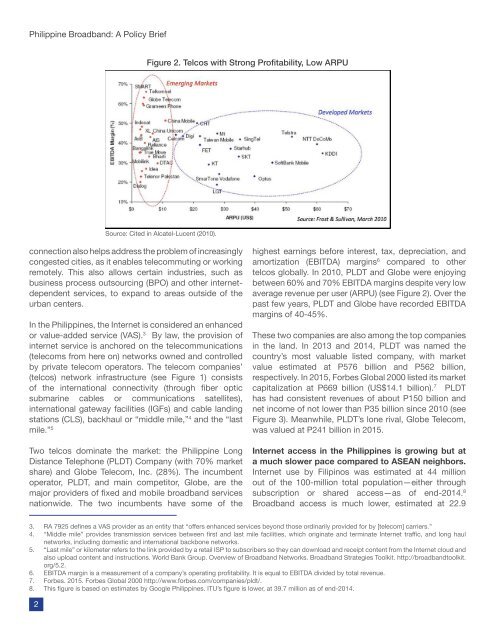Philippine Broadband A Policy Brief
ONLINE-BROADBAND-POLICY-BRIEF1
ONLINE-BROADBAND-POLICY-BRIEF1
Create successful ePaper yourself
Turn your PDF publications into a flip-book with our unique Google optimized e-Paper software.
<strong>Philippine</strong> <strong>Broadband</strong>: A <strong>Policy</strong> <strong>Brief</strong><br />
Figure 2. Telcos with Strong Profitability, Low ARPU<br />
Source: Cited in Alcatel-Lucent (2010).<br />
connection also helps address the problem of increasingly<br />
congested cities, as it enables telecommuting or working<br />
remotely. This also allows certain industries, such as<br />
business process outsourcing (BPO) and other internetdependent<br />
services, to expand to areas outside of the<br />
urban centers.<br />
In the <strong>Philippine</strong>s, the Internet is considered an enhanced<br />
or value-added service (VAS). 3 By law, the provision of<br />
internet service is anchored on the telecommunications<br />
(telecoms from here on) networks owned and controlled<br />
by private telecom operators. The telecom companies’<br />
(telcos) network infrastructure (see Figure 1) consists<br />
of the international connectivity (through fiber optic<br />
submarine cables or communications satellites),<br />
international gateway facilities (IGFs) and cable landing<br />
stations (CLS), backhaul or “middle mile,” 4 and the “last<br />
mile.” 5<br />
Two telcos dominate the market: the <strong>Philippine</strong> Long<br />
Distance Telephone (PLDT) Company (with 70% market<br />
share) and Globe Telecom, Inc. (28%). The incumbent<br />
operator, PLDT, and main competitor, Globe, are the<br />
major providers of fixed and mobile broadband services<br />
nationwide. The two incumbents have some of the<br />
highest earnings before interest, tax, depreciation, and<br />
amortization (EBITDA) margins 6 compared to other<br />
telcos globally. In 2010, PLDT and Globe were enjoying<br />
between 60% and 70% EBITDA margins despite very low<br />
average revenue per user (ARPU) (see Figure 2). Over the<br />
past few years, PLDT and Globe have recorded EBITDA<br />
margins of 40-45%.<br />
These two companies are also among the top companies<br />
in the land. In 2013 and 2014, PLDT was named the<br />
country’s most valuable listed company, with market<br />
value estimated at P576 billion and P562 billion,<br />
respectively. In 2015, Forbes Global 2000 listed its market<br />
capitalization at P669 billion (US$14.1 billion). 7 PLDT<br />
has had consistent revenues of about P150 billion and<br />
net income of not lower than P35 billion since 2010 (see<br />
Figure 3). Meanwhile, PLDT’s lone rival, Globe Telecom,<br />
was valued at P241 billion in 2015.<br />
Internet access in the <strong>Philippine</strong>s is growing but at<br />
a much slower pace compared to ASEAN neighbors.<br />
Internet use by Filipinos was estimated at 44 million<br />
out of the 100-million total population—either through<br />
subscription or shared access—as of end-2014. 8<br />
<strong>Broadband</strong> access is much lower, estimated at 22.9<br />
3. RA 7925 defines a VAS provider as an entity that “offers enhanced services beyond those ordinarily provided for by [telecom] carriers.”<br />
4. “Middle mile” provides transmission services between first and last mile facilities, which originate and terminate Internet traffic, and long haul<br />
networks, including domestic and international backbone networks.<br />
5. “Last mile” or kilometer refers to the link provided by a retail ISP to subscribers so they can download and receipt content from the Internet cloud and<br />
also upload content and instructions. World Bank Group. Overview of <strong>Broadband</strong> Networks. <strong>Broadband</strong> Strategies Toolkit. http://broadbandtoolkit.<br />
org/5.2.<br />
6. EBITDA margin is a measurement of a company’s operating profitability. It is equal to EBITDA divided by total revenue.<br />
7. Forbes. 2015. Forbes Global 2000 http://www.forbes.com/companies/pldt/.<br />
8. This figure is based on estimates by Google <strong>Philippine</strong>s. ITU’s figure is lower, at 39.7 million as of end-2014.<br />
2


